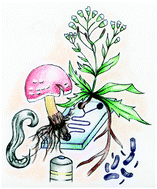Soil-on-a-Chip: microfluidic platforms for environmental organismal studies
Abstract
Soil is the habitat of countless organisms and encompasses an enormous variety of dynamic environmental conditions. While it is evident that a thorough understanding of how organisms interact with the soil environment may have substantial ecological and economical impact, current laboratory-based methods depend on reductionist approaches that are incapable of simulating natural diversity. The application of Lab-on-a-Chip or microfluidic technologies to organismal studies is an emerging field, where the unique benefits afforded by system miniaturisation offer new opportunities for the experimentalist. Indeed, precise spatiotemporal control over the microenvironments of soil organisms in combination with high-resolution imaging has the potential to provide an unprecedented view of biological events at the single-organism or single-cell level, which in turn opens up new avenues for environmental and organismal studies. Herein we review some of the most recent and interesting developments in microfluidic technologies for the study of soil organisms and their interactions with the environment. We discuss how so-called “Soil-on-a-Chip” technology has already contributed significantly to the study of bacteria, nematodes, fungi and plants, as well as inter-organismal interactions, by advancing experimental access and environmental control. Most crucially, we highlight where distinct advantages over traditional approaches exist and where novel biological insights will ensue.

- This article is part of the themed collections: Lab on a Chip Recent Review Articles and Lab on a Chip 2016 Most Downloaded Articles

 Please wait while we load your content...
Please wait while we load your content...